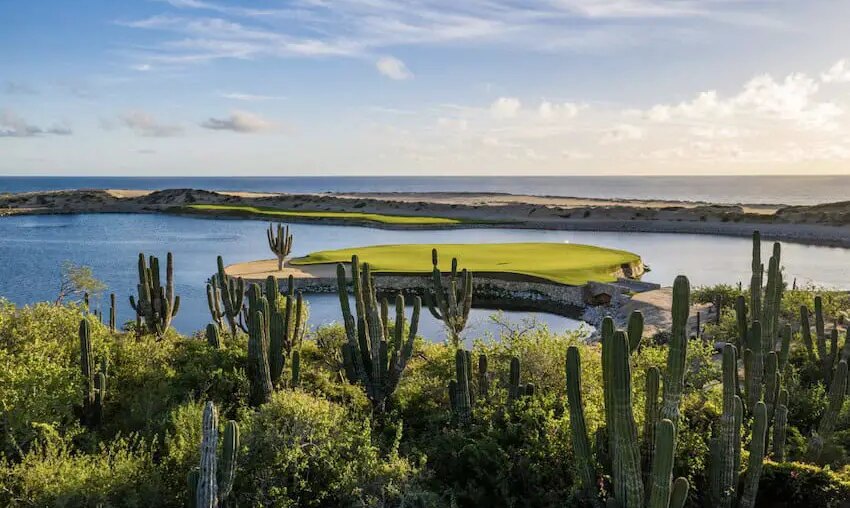The three most common criticisms of golf courses are that they’re elitist, wasteful of water, and destructive to wildlife habitats. In Los Cabos, where most courses cost upwards of $200 per round, and some more than double that, the charge of elitism is hard to refute. Very few locals can afford to play any of the 18 courses currently open; and since many are private — with tee times only available to resort guests or homeowners in gated communities — it’s often a moot point.
Of course, it’s also true that tourism and real estate are tent poles of the Los Cabos economy and that golf courses provide many good-paying jobs to locals. But these courses are typically exclusive. That’s not in dispute.


Los Cabos golf courses are often wildlife-friendly
The other two criticisms are more complicated, and one (the threat to wildlife habitats) has been shown in some case studies to be misguided. A recent USGA article on the environmental benefits of golf cites three studies that support the idea that golf courses provide healthy habitats for endangered species. So golf courses generally aren’t harmful to wildlife. Quite the contrary, they’re often wildlife sanctuaries. It makes sense if you think about it. As urban developments increase, the animals displaced naturally seek out the few available areas with greenery, foliage, and wide-open spaces.
Solmar Golf Links in Los Cabos qualified as a Certified Audubon Cooperative Sanctuary in 2021, making it one of only 900 of the over 38,000 golf courses worldwide to have received environmental certification from Audubon International (Twin Dolphin Golf Club is the only other in Los Cabos). Golfers on both these courses can’t help but notice the thriving wildlife. In fact, in Audubon International’s 2024 BioBlitz, a “free species-counting competition designed to showcase the environmental value of the natural habitats found on golf courses,” Twin Dolphin Golf Club was a winner, with a photo capturing a bee cocoon — many bee species are threatened worldwide — flourishing in one of its trees. Wildlife also abounds on Solmar Golf Links, from lizards and correcaminos (roadrunners) to seasonal sightings of whales transiting just offshore.
That’s not to say the other 16 Los Cabos courses aren’t wildlife-friendly. But there are local courses that take sustainability to another level with habitat protection, just as there are when it comes to water use.


Why water use on Los Cabos courses more complicated than you think
Yes, golf courses do use a lot of water for irrigation. However, many course superintendents care about environmental impacts and are trying to find new ways to reduce water use. Over the past two decades, they’ve proven to be very successful at doing so. In the U.S., for example, water use by golf courses has declined by 29% since 2005.
How has this been accomplished? One way is to strategically reduce areas that need to be irrigated to conserve water, a practice that Solmar Golf Links has implemented, as has its Cabo San Lucas neighbor Quivira Golf Club. Another is to install grasses for fairways and greens that aren’t as water-intensive. In a recent article in Forbes, course architect Jan Bel Jan discussed one of the projects she was proudest to have been part of, the opening of the Tom Fazio-designed Old Collier Golf Club in Naples, Florida in 2001. “It was the first course that used the new Seashore Paspalum turf type and that was important because it could tolerate up to 36,000 parts per million salt. So we were able to grow a golf course using salt water right out of the ocean.”
Varieties of seashore paspalum have since been installed at several Los Cabos golf courses, including Club Campestre, Puerto Los Cabos, Solmar Golf Links, Quivira Golf Club, and both El Cardonal and the Dunes Course at Diamante. These paspalum varieties are salt-tolerant, require fewer chemicals and pesticides, and can be irrigated with greywater (effluent water that is treated and disinfected). Quivira, for example, has its own wastewater treatment plant that can treat and disinfect sewage from nearby residents in Cabo San Lucas for irrigation purposes, noted the course’s Director of Golf Antonio Reynante in a 2024 issue of Golf Business Magazine. Quivira irrigates fairways according to how much greywater is available, a sustainability-friendly plan that also provides an enormous benefit in terms of no-cost service to the city. Greens, meanwhile, are watered from retention lakes.


The case for greater oversight of golf course water use in Los Cabos
So some responsibly managed golf courses in Los Cabos like Solmar Golf Links and Quivira Golf Club exist as do proven pathways to sustainability. But these sustainable practices haven’t been implemented at all local courses and there are lots of them: 18, as previously noted, with five more in development.
To put this in perspective, upkeep for each layout necessitates 2,300 cubic meters of water per day on average – the equivalent of over 600,000 gallons and enough to satisfy the daily needs of 8,000 residents, per the 2019 article “A critical geography approach to land and water use in the tourist economy in Los Cabos, Baja California Sur, Mexico” published in the Journal of Land Use Science by authors Juan Carlos Graciano, Manuel Ángeles, and Alba E. Gámez.
That’s for one course. Multiply that by the 23 courses expected to be open within the next couple of years and the numbers are staggering. You’re talking about enough water to service 184,000 people per day — more than half the current population of Los Cabos. Instead, it’s being diverted to golf courses enjoyed by a small group of affluent people, many of whom don’t live here.
Again, not all of these golf courses are using municipal water sources. So that number is likely inflated. Still, it’s obvious why so many people are upset about this seemingly frivolous use of such a critical resource; especially since Los Cabos is already operating at a water deficit as local aquifers aren’t recharged fast enough to keep up with demand. At the very least, water consumption from local golf courses should probably be tracked and reported, with some governmental oversight.
Chris Sands is the Cabo San Lucas local expert for the USA Today travel website 10 Best, writer of Fodor’s Los Cabos travel guidebook, and a contributor to numerous websites and publications, including Tasting Table, Marriott Bonvoy Traveler, Forbes Travel Guide, Porthole Cruise, Cabo Living and Mexico News Daily. His specialty is travel-related content and lifestyle features focused on food, wine and golf.

